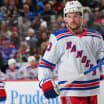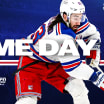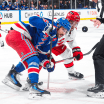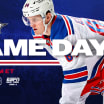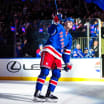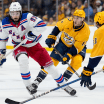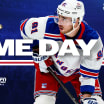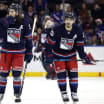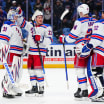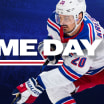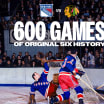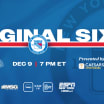NYRangers.com is getting ready to celebrate the 25th Anniversary of the 1994 Stanley Cup Champion Rangers, and to welcome back the players and coaches and staff for a one-of-a-kind celebration on Feb. 8 at the Garden. We'll be looking back at a few of the memorable moments and characters that made the joy of this championship season one that will last a lifetime.
LEARN MORE & GET TICKETS »
If you were to take yourself back to 1994 and, in the fashion of the time, make a mix tape of a championship season, what kind of soundtrack would you compile? You might begin and end with "Matteau! Matteau! Matteau!" "This one will last a lifetime," sure - and sprinkle in an "Oh Baby" here and there, and maybe something in that unique dialect called Tikkanese, even if Esa Tikkanen might be the only person alive who could decipher it.
But if you wanted to get to ground level and capture the day-to-day of the 1993-94 Stanley Cup Champion Rangers, from the exhibition journey to London through the cruise down the Canyon of Heroes, you'll need this sound, too:
HEAVE-HO! HEAVE-HO! HEAVE-HO!
"It was our rallying cry," said Eddie Olczyk, who led the daily recitations that season. "Because when I think of Heave-Ho, I think of work and I think of together. And that's something that we did as well as anybody - we were together, and we worked."
1994 Championship Memories: Eddie Olczyk and the Black Aces

The rallying cry became part of the indelible stamp put on a team that proved deep and dominant all season long, a stamp laid individually by Olczyk and as a group by the Rangers' merry band of extras known as the Black Aces. It was a collection of players who had to scratch and claw to avoid being scratched themselves, who didn't see the ice time that they wanted or perhaps expected, but who made a commitment to themselves and to one another that they would remain a positive influence on the team and jump at any chance to contribute, whether it was each day in practice or in the dressing room or on a bus ride, wherever. And they encouraged and pushed one another even as they were in direct competition for spots.
"We just kind of supported each other as we went through the year," said Doug Lidster. "And on those occasions when one of us would get in the lineup, we were cheering for them. Not that we would cheer against our other teammates, but you form a special bond with those guys."
Olczyk, a 342-goal scorer over 16 NHL seasons, and now most visible as the lead TV analyst for his hometown Blackhawks as well as the NHL on NBC - and nearing one year cancer-free following chemotherapy to treat colon cancer - took on a job description in 1993-94 that wound up thrusting him into a front-and-center role among this group, although it was not what he had anticipated or grown accustomed to. He was 26 years old when he was traded to the Rangers in December of 1992, and coming off of five consecutive 30-goal seasons with the Maple Leafs and Jets. "I wasn't a flash-in-the-pan player," Olczyk said. "I had earned becoming a go-to guy who could score goals."
Once 1993-94 rolled around, with Mike Keenan taking over the helm of the Rangers, "the season started and pretty much I knew exactly what my role was going to be," said Olczyk, who played in 36 of the team's first 48 games before "shattering my thumb" in a game in Anaheim. "It was a battle for me to be in the lineup, that's just the way it was," he said. "So I knew what my role was and I carried it out to the best of my abilities. Whether I was in the lineup or not, I was going to do my part."
That was another kind of rallying cry for Olczyk and the rest of the Black Aces, which included the likes of Lidster, Mike Hartman, Mike Hudson, Nick Kypreos, Peter Andersson and Glenn Healy, the backup goaltender. Andersson didn't finish the season with the Rangers but he scored one of the regular season's memorable goals, as anyone who has watched the "Oh Baby!" video will remember, deking around Quebec's Stephane Fiset in a March 2 game and pointing up toward the rafters in celebration, to the box where his fellow Black Aces were going bananas.
"It was a good group of guys, and we came and worked as hard as we could for any opportunity that we could get, and we tried to do the best that we could," Lidster said. "I'm not going to tell you that it was easy; it wasn't. There were days where we were frustrated, and you're kind of wondering what was ahead for us, I guess. But there was something about being in that group of guys that kind of banded together and battled together and worked together and tried to prepare each other and stay prepared ourselves.
"We were all in a situation where we realized that we wanted to be a part of something bigger. Your first goal is to play in the NHL, to be a contributor, to be a regular; but your ultimate goal is to win the Stanley Cup. And we realized this was a situation that might not ever come again. So we bonded together and we pushed each other."
Part of Olczyk's duties to push his teammates was to lead the stretch in practice and in the pregame skates, and he would always finish it up with "three Heave-Hos together." "You'd just take your arms and get them parallel to the ground like you're making fists at somebody, two hands out," Olczyk explained, "and then you'd bring your fists back like you're sitting on a bench, like you're pushing. You'd do three of those, every time.
"When I was a kid, you know when you're getting ready to get to work and you put the work boots on, it's Heave-Ho together - everybody Heaves and everybody Hos together, so to speak. That was the way we ended our stretch and we took that with us."
For one measure of the extent to which Olczyk did his part, after the season was over, and after the Cup and the Conn Smythe and the Prince of Wales and Presidents' trophies had all been handed out, there was one more honor to bestow: The Rangers voted that the Players' Player Award would go to Eddie Olczyk.
"When the guys voted me the Players' Player, that was very, very humbling and honoring," Olczyk said. "To have an impact on our team that eventually wins the Stanley Cup, but for someone who didn't have much of a role on the ice, certainly the guys looked at me as an important piece. There's no doubt that that's the ultimate individual award I've ever had in my life - obviously individually, not team-wise, because the Cup was the greatest. But to get that award in that season - look, I wanted to play, everybody wanted to play, that's the reality, but I knew my role, and I carried it out. So it's something I'm very proud of."
Like Olczyk, Lidster arrived in a trade before the '93-94 season began, coming over from his hometown Canucks after playing 10 seasons in Vancouver, to complete the move of John Vanbiesbrouck. Lidster made his way into 34 games in the regular season, and none in the first two rounds of the playoffs. But when Jeff Beukeboom was suspended for Game 6 of the Eastern Conference final against the Devils, Lidster, after six weeks without playing a game, stepped into the lineup with the Rangers facing elimination in New Jersey.
"You know, I was rusty," Lidster said. "But we had prepared for this, and I kept telling myself, I'm fresher than the other guys - they've gone through it, they're tired, they're beat up. I can bring energy. And I kept telling myself, 'This is your opportunity - don't waste it.'"
He didn't, and he never left the lineup, playing in Games 6 and 7 against the Devils and all seven in the Stanley Cup Final, which happened to be against the team he had spent a decade playing for. Lidster remembers watching his old teammates' run to the Final that year and thinking, "This could be a nightmare for me." Instead, after the Rangers dropped Game 1 in overtime, Lidster opened the scoring in Game 2 - his first goal in 16 months - then scored another one in Game 5 and finished Game 7 lifting the Cup over his head.
For those efforts, when you take a good look at the Stanley Cup, and peruse those names carved beneath "New York Rangers 1993-94," you'll see D. Lidster right there in its place in the (mostly) alphabetical order. But you'll have to get to the end of the roll call to find the names E. Olczyk and M. Hartman.
That's because those two didn't qualify for the engraver. The criteria for getting your name on the Cup was playing 40 games during the regular season or at least one game in the Stanley Cup Final. Lidster made the cut the second he stepped on the ice in Game 1 against the Canucks, while Olczyk had to his credit 37 games in the regular season and the one playoff game against the Devils, and Hartman, who had suffered a serious eye injury from a James Patrick slap shot during an early-season practice, was limited to 35 games during the year; neither player cracked the lineup in the Final.
General Manager Neil Smith, Adam Graves, Brian Leetch and others in the Rangers' leadership and executive groups waged their appeals to the league, expressing each player's contributions to the team and asking for the thresholds to be set aside. It wasn't until the day before the Rangers were to raise their championship banner, before the Jan. 20, 1995, home opener, that the league announced it would be adding two names to the Rangers' segment of the Stanley Cup.
"I was at peace to know that even though my name might not be on the Stanley Cup, nobody was ever going to tell me that I didn't have an important piece, and that I didn't have an impactful part of that team. So I was at peace already," said Olczyk, a horse-racing fanatic who in July of '94 took the Cup to Belmont Park for use as a feedbag for Kentucky Derby-winner Go For Gin. "But then the team lobbied, and then one day we find out that me and Harty are going to get our names on the Cup, and I will always be grateful for that.
"Forever is a long time. It'll certainly be there forever and I'm very proud of that."
Hartman had similar feelings, and even stressed his gratitude to perhaps an unlikely backer to his cause: Mike Gartner, whom the Rangers had traded away just weeks before the playoffs but who joined the lobbying effort on the two players' behalf.
"That put a tear in my eye, because you're there all year, you're on the team all year, and the rule was just the rule," Hartman said. "But it's even more when you have your teammates, and Neil Smith - to have people like that fighting to get your name on the Stanley Cup. Their names are on it, they're part of it already, they're all in the moment, and they go out of their way to do that. And even Mike Gartner, who got traded? I'll never forget that."
Olczyk's and the Black Aces' contributions are etched on some other hardware, too, and this one was unanimous: Amid all the adornments to the Rangers' Stanley Cup rings, the shield and the skyline and the names and the "112 pts.," down one side of the ring there is carved one phrase: "Heave-Ho."
"I'm not much of a jewelry guy by any stretch, but I'll pop on my ring every once in a while and just think back and look at some pictures and just live in the past," Olczyk said, "and when I pull it off, I see the "Heave-Ho" on the side of the ring. And I think, That's forever, too. That's forever. And that's something that's really special."
2018-19 Rangers Tickets Are on Sale Now. Click Here to Get Tickets »

